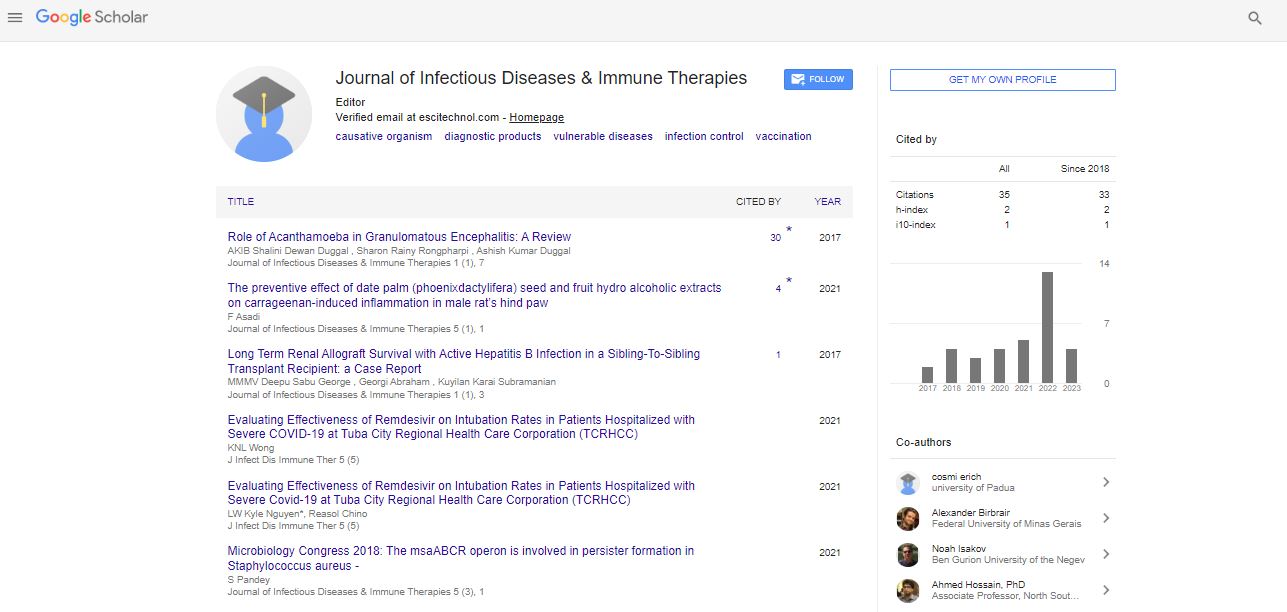Editorial, J Infect Dis Immune Ther Vol: 5 Issue: 8
Infection and Its Treatment Techniques: An Overview
Pravadha Sena*
Department of Immune Therapies, Datta Meghe Institute of Medical Sciences, Wardha, Maharastra, India
*Corresponding Author:
Pravadha Sena, Department of Immune Therapies
Datta Meghe Institute of Medical Sciences, Wardha, Maharastra, India
E-mail: sena.pavadhasp@gmail.com
Received: August 13, 2021; Accepted: August 27, 2021; Published: September 03, 2021
Citation: Sena P (2021) Infection and Its Treatment Techniques: An Overview. J Infect Dis Immune Ther 2021, 5:5
Abstract
Infection occurs due to germ invasion and growth in the body. Bacteria, viruses, yeast, fungi, and other microorganisms are examples of germs. Infections can start anywhere in the body and spread throughout it. Depending on where an infection occurs in the body, it can cause fever and other health problems. When the immune system of the body is strong, it can often fight germs and cure an infection. Infection occurs when germs enter the body, multiply, and cause a reaction in the body. In order for an infection to occur, three Habitats of infectious agents (germs) (e.g., sinks, surfaces, human skin), Susceptible Individual with a path for germs to enter the body which is the process through which germs are transmitted to a susceptible individual. Infections are categorized into four types.
Keywords: Bacteria are microorganisms, Antibiotics, Yeasts
Description
Infection occurs due to germ invasion and growth in the body. Bacteria, viruses, yeast, fungi, and other microorganisms are examples of germs. Infections can start anywhere in the body and spread throughout it. Depending on where an infection occurs in the body, it can cause fever and other health problems. When the immune system of the body is strong, it can often fight germs and cure an infection. Infection occurs when germs enter the body, multiply, and cause a reaction in the body. In order for an infection to occur, three Habitats of infectious agents (germs) (e.g., sinks, surfaces, human skin), Susceptible Individual with a path for germs to enter the body which is the process through which germs are transmitted to a susceptible individual. Infections are categorized into four types. They are: (a) Viral Infections (b) Bacterial Infections (c) Fungal Infections (d) Invasive Infections. Viruses are extremely small infectious organisms. They are even more microscopic than bacteria. A virus, in its most basic, is comprised of a piece of genetic material surrounded by a protein shell. Some viruses may have an additional envelope or other surface features. Viruses are parasitic and must live inside a host cell to complete their life cycle. Once inside the host cell, the virus can reproduce by utilizing cellular components. New viruses are released from the host cell, causing the host cell to die in some cases. Common cold, measles, rubella, chickenpox, nor virus, polio, etc. are some of the examples of viral infections. Most viral infections are treated by relieving symptoms until your immune system clears the infection. In some cases, antiviral drugs may be available to aid in the treatment of a viral infection. HIV (Human Immunodeficiency Virus), herpes, and hepatitis C are a few examples of viral infections for which antivirals are available.
Bacteria are microorganisms with one cell. They are extremely diverse, coming in a wide range of shapes and sizes. Bacteria can be found in a variety of environments, including soil and bodies of water, as well as in or on our bodies. Some can withstand high temperatures or even radiation exposure.
Antibiotics are commonly used to treat bacterial infections. Antibiotics are drugs that inhibit bacterial growth. They can either prevent bacteria from multiplying or kill them completely.
Fungi are a diverse group of organisms that can include yeasts and moulds. They can be found in a variety of environments, including soil, indoors in moist areas such as bathrooms, and on or in our bodies. Fungi can be so small that they are invisible to the naked eye at times. You can see them at times, such as when you notice mould on your bathroom tiles. Antifungal medications can be used to treat fungal infections. The type of medication prescribed to you will be determined by the type of fungal infection you have. Parasites live on or in a host organism, obtaining food or other nutrients at the expense of the host. Human illness can be caused by three types of parasites: Protozoa are single-celled organisms. Helminthes are worm-like, larger organisms. Eco parasites are organisms like fleas, ticks, and lice. Infections caused by parasites include the following: malaria \toxoplasmosis Trichomonasis, Giardiasis, and Tapeworm Infection with roundworms. A parasitic infection, like bacterial and fungal infections, can be treated with specific drugs. The type of antiphrastic medication you'll need will be determined by the parasite that's causing your infection. Infection was cured with specific drugs like antiviral, antibiotics, antiphrastic drugs are used for the some of the infections. Infection control must include patient, caretaker, and health care personnel education about good preventive measures. These precautions should include proper hand hygiene, the use of PPE or isolation when necessary, and the careful use of antibiotics.
 Spanish
Spanish  Chinese
Chinese  Russian
Russian  German
German  French
French  Japanese
Japanese  Portuguese
Portuguese  Hindi
Hindi 